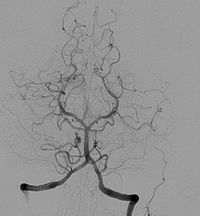
Photo from wikipedia
Study Design. Cadaveric. Objective. Determine optimal fluoroscopic views for detecting cervical lateral mass screw (LMS) violations. Summary of Background Data. Single plane intraoperative x-rays are commonly used but frequently inadequate… Click to show full abstract
Study Design. Cadaveric. Objective. Determine optimal fluoroscopic views for detecting cervical lateral mass screw (LMS) violations. Summary of Background Data. Single plane intraoperative x-rays are commonly used but frequently inadequate due to its complex trajectory. Fluoroscopy can be taken in multiple planes, but the ideal fluoroscopic view to assess malposition is not known: depending on the view, any given screw may look “in” or “out.” Methods. C3–6 LMS were inserted in three cadavers. To evaluate neuroforaminal violation, LMS were inserted into the foramen with the tip penetrating the anterior cortex by 0, 2, and 4 mm. To assess facet joint violation, LMS were inserted toward the subjacent facet joint with the tip penetrating the anterior cortex by 0 and 2 mm. Fluoroscopic views were taken 0°, 10°, 20°, 30°, and 40° to the lateral plane. Views were independently evaluated by three blinded spine surgeons. Results. Twenty-degree oblique view correctly identified a 2 mm penetration into the neuroforamen in 79%, and a 4 mm penetration in 86%, for a sensitivity of 83% and specificity of 90%. Thirty-degree view had lower sensitivity (76%) but slightly higher specificity (93%). Twenty-degree and 30° views were significantly more sensitive than the other views. Zero-degree view correctly identified a 2 mm penetration into the facet joint in 93%, for a sensitivity of 93% and specificity of 92%. Ten-degree view had lower sensitivity (72%) but higher specificity (100%). The 0° view was significantly more sensitive than the other views. Conclusion. Twenty-degree and 30° oblique views significantly provided the most sensitive assessment of LMS potentially violating the neuroforamen, whereas the 0° neutral lateral view significantly provided the most sensitive assessment of facet violations. The specificities were also high (in the 90% range) for these views. We recommend the use of these views intraoperatively when assessing proper placement of LMS fluoroscopically. Level of Evidence: N/A
Journal Title: SPINE
Year Published: 2017
Link to full text (if available)
Share on Social Media: Sign Up to like & get
recommendations!